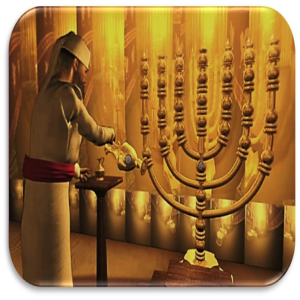The Golden Lampstand

With no windows or other means to allow natural light, the only illumination in the Holy Place came from the supremely beautiful Golden Lampstand. Like the Laver just outside, the Bible gives no dimensions for its size. However, we are told that it was made of pure gold that had a weight of one talent, approximately 125 pounds. Based on the 2020 price of gold, $2.369,875 million of the precious metal was used to make the lampstand. It was hammered from one piece of gold, making it seamless and requiring the utmost skill to craft its exquisite shape. There were six branches, three on each side and then a vertical one, giving seven lamps on the stand. Each stem had three groups of almond blossom cups, knobs and flowers except the middle stem that had four.
Besides the practical nature of the lampstand providing light, there are several spiritual lessons that can be learned from its symbolism.
First and most obviously, the Golden Lampstand reminds us of Christ, the Light of the World. In its capacity, the lampstand revealed the other objects in the Holy Place. Its light reflected the gold of the other furnishings and the Urim and Thummim’s jewels on the High Priest’s chest. The glow from the light bathed the veil that separated the Holy Place from the Holy of Holies, revealing the beauty of its tapestry. In the same way, Christ reveals to us what is beautiful, making things more beautiful still because of His light.
In addition, the lampstand not only showed the beauty of what was around but its own glory. In the same way, Christ reveals His own beauty by His illumination in our lives.
The second thing we can observe is the light could only be seen by the priests, hidden away from the world by the coverings of the Tabernacle. The believer, because of his/her relationship with Christ is able to see things that the world simply cannot see. As the priests had to be in the Tabernacle to benefit from the lampstand, we have to be in Christ to see what only He can reveal. This is also why unbelievers are frequently mystified by the realities of the Chvbistian faith. Without the illumination of God those things remain unseen.
At the end of each branch there was a wick fueled by olive oil. The wicks were trimmed daily to remove any charred material that would hinder the lamp from burning brightly. When the light is shining brightly, the wick is not seen, but if the light goes out, only the black charred wick is noticed. From this we learn that as long as we burn for the Lord, He is seen, He is glorified. But if our lamp goes out by our lack of attention and care to our spiritual life, then what was bright becomes ugly and unusable. We must always remember that God works with us in partnership. He provides the lamp, the fuel, the fire but we must do our part in keeping ourselves trimmed from anything that would keep us from shining brightly for the Lord.
The lampstand was meant to burn perpetually (Exodus 27:20-21). The lamps were to be filled with olive oil that was prepared by crushing the olives to draw out the oil. The priests would then consecrate the oil for holy purposes. We are reminded of our Lord who suffered a cruel death, His body and soul crushed by the devil, His tormenters, and left to die by the indifferent. From that torment His blood flowed, consecrated for our salvation. In a similar way, the servant of God finds that his/her offering is often tested in the crucible of suffering but from that flows a purified offering for the Lord’s use. We are crushed, but not destroyed. We are tested so that we can be used.
The Golden Lampstand then speaks first of Christ. But it also speaks to us in our ministry, whatever that might be. The Golden Lampstand was put in its place not only to draw attention to its own splendor but to allow for the other furnishings in the Holy Place to be used. We are in our places, not only to shine as we should but to serve others so that they can fulfill their purpose that God designed. We cannot escape the obligation for service any more than the lampstand could satisfy its destiny by solely burning its flame so that it could be the object of everyone’s attention.







 Follow
Follow

